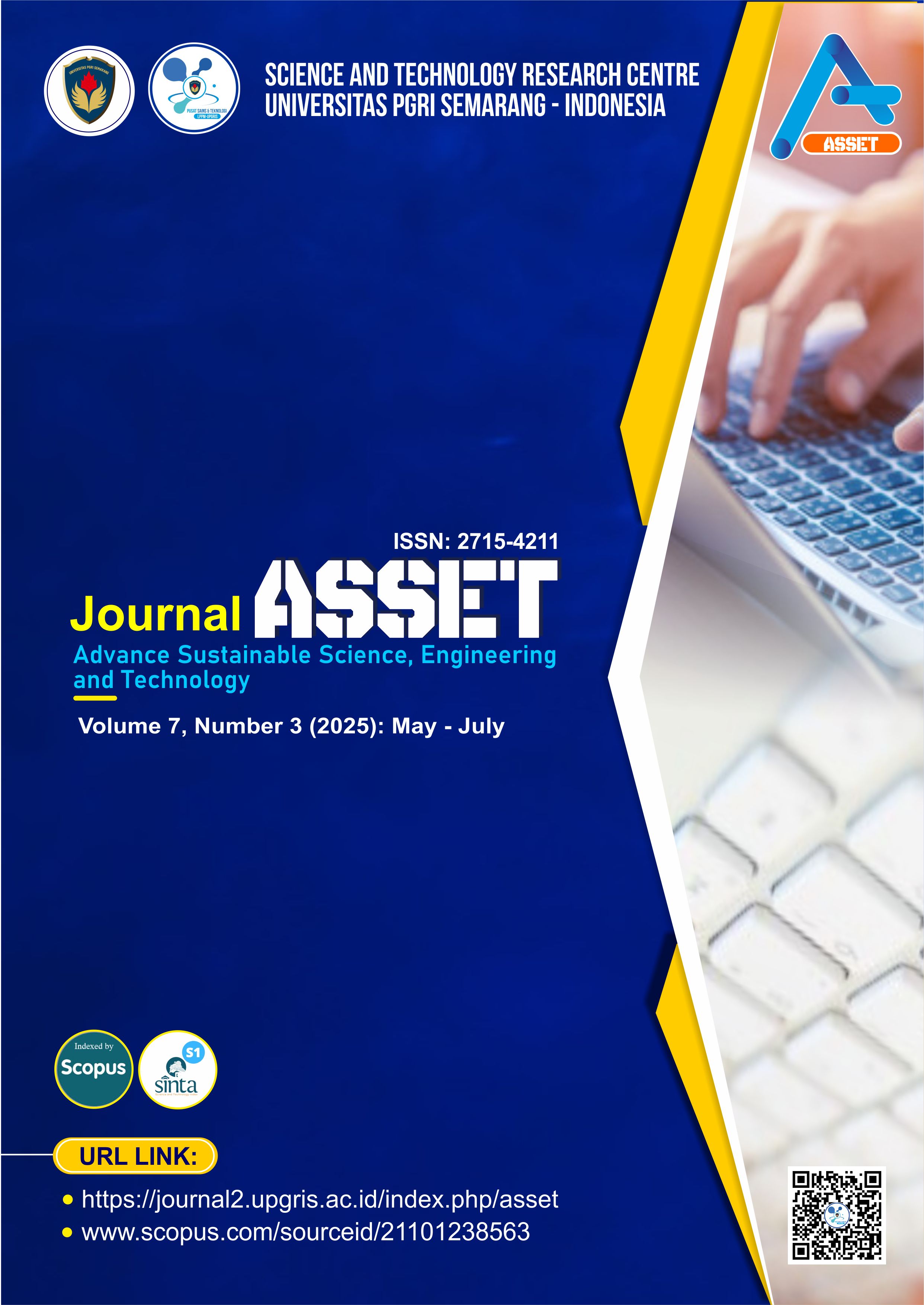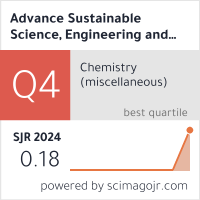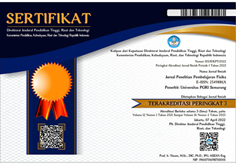Barium Removal from Produced Water Using RCC-Based Ceramic Adsorbent: Fixed-Bed Column Adsorption
DOI:
https://doi.org/10.26877/asset.v7i4.2399Keywords:
barium removal, fixed-bed adsorption, ceramic adsorbent, produced water, breakthrough curveAbstract
This study focuses on the removal of barium ions (Ba²⁺) from produced water, a common challenge in industrial wastewater treatment due to barium’s toxicity and scaling potential. To address this, the research introduces a novel ceramic composite adsorbent formulated from natural clay and residue catalytic cracking (RCC) spent catalyst, combining low cost, sustainability, and enhanced adsorption performance. The main objective is to evaluate the adsorption efficiency of this composite in a fixed-bed column system under varying operational conditions, while also modeling its dynamic behavior. Produced water with an initial barium concentration of 0.58 mg/L (pH 8.8) was fed in up-flow mode at flow rates of 6, 7, and 8 mL/min using a peristaltic pump. Effluent samples collected over 180 minutes were analyzed by UV- Vis. spectrophotometry. Results showed that lower flow rates increased contact time and improved adsorption efficiency, with breakthrough delayed to ~210 minutes at 6 mL/min compared to 160 minutes at 8 mL/min. Breakthrough modeling indicated that the Thomas model best represented the data (R² ≥ 0.95), while the Yoon–Nelson model reliably predicted 50% breakthrough time. This work demonstrates that clay–RCC ceramic composites are effective, low-cost, and sustainable adsorbents.
References
[1] M. A. Al-Ghouti, M. A. Al-Kaabi, M. Y. Ashfaq, and D. A. Da’na, “Produced water characteristics, treatment and reuse: A review,” J. Water Process Eng., vol. 28, no. January, pp. 222–239, 2019, doi: http://10.1016/j.jwpe.2019.02.001.
[2] Igunnu & Chen, “Produced Water Treatment Technologies,” Int. J. Low-Carbon Technol., vol. 9, no. 3, pp. 157–177, 2012, doi: https://doi.org/10.1093/ijlct/cts049.
[3] Rusdi et al., “Total Dissolved Solids, Phenol, and Barium Removals from Oilfield Produced Water Using Kapok Fibers and Ultrafiltration Membrane,” Period. Polytech. Chem. Eng., vol. 67, no. 3, pp. 452–459, 2023, doi: https://doi.org/10.3311/PPch.21802.
[4] Ibrahim et al., “Advances in Produced Water Treatment Technologies: An In-Depth Exploration with an Emphasis on Membrane-Based Systems and Future Perspectives,” Water, vol. 15, no. 16, p. 2980, 2023, doi: https://doi.org/10.3390/w15162980.
[5] Mahmoud & Salaheldin Elkatatny, “Removal of Barite-Scale and Barite-Weighted Water- or Oil-Based-Drilling-Fluid Residue in a Single Stage,” SPE Drill Compl, vol. 34, no. 01, pp. 16–26., 2019, doi: https://doi.org/10.2118/187122-PA.
[6] A. A. Novira, S. Nasir, and F. Hadiah, “Produced Water Treatment Using The Residue Catalytic Cracking (RCC) Spent Catalyst As Ceramic Filter Material Integrated With Reverse Osmosis (RO) System,” J. Appl. Sci. Eng., vol. 26, no. 3, pp. 403–411, 2022, doi: http://10.6180/jase.202303_26(3).0011.
[7] Hussein et al., “Examining the factors that impact the formation of barite scale in water injection operations: experimental study and quantification of scale formation,” Discov. Appl. Sci., vol. 6, no. 10, 2024, doi: https://doi.org/10.1007/s42452-024-06176-7
[8] J. Al Jaberi et al., “Minimizing the Barite Scale in Carbonate Formations during the Filter Cake Removal Process,” ACS Omega, 2022, doi: 10.1021/acsomega.2c01339
[9] Dai et al, “Prediction Models of Barite Crystallization and Inhibition Kinetics: Applications for Oil and Gas Industry,” Sustain., vol. 13, no. 15, p. 8533, 2021, doi: https://doi.org/10.3390/su13158533.
[10] Ahmad et al., “Fate of radium on the discharge of oil and gas produced water to the marine environment,” Chemosphere, vol. 273, p. 129550, 2021, doi: https://doi.org/10.1016/j.chemosphere.2021.129550.
[11] J. Kravchenko, T. H. Darrah, R. K. Miller, H. K. Lyerly, and A. Vengosh, “A review of the health impacts of barium from natural and anthropogenic exposure,” Environ. Geochem. Health, 2014, doi: 10.1007/s10653-014-9622-7.
[12] Zsirka, B., et al. “Heavy metal adsorption by mechanically activated red mud: batch study,” J. Environ. Chem. Eng., vol. 9, no. 6, p. 106450, 2021, doi: https://doi.org/10.1016/j.jece.2021.106450.
[13] Barbosa et al., “Phytoremediation in flooded environments: Dynamics of barium absorption and translocation by Eleocharis acutangula,” Chemosphere, vol. 219, pp. 836–844, 2019, doi: https://doi.org/10.1016/j.chemosphere.2018.12.07.4
[14] Bageri et al, “Toward a Complete Removal of Barite (Barium Sulfate BaSO4) Scale Using Chelating Agents and Catalysts,” Arab. J. Sci. Eng., vol. 42, pp. 1667–1674, 2017, [Online]. Available: https://link.springer.com/article/10.1007/s13369-017-2417-2.
[15] Z. Luo et al., “A chelating agent system for the removal of barium sulfate scale,” J. Pet. Explor. Prod. Technol., 2020, doi: 10.1007/s13202-020-00886-5.
[16] M. I. Aly, M. R. Hassan, M. M. Ghobashy, and B. A. Masry, “Removal of barium (II), cobalt (II), and strontium (II) from aqueous solution using chemically modified poly (acrylonitrile‐butadiene‐styrene) pellets,” Part. Sci. Technol., 2022, doi: 10.1080/02726351.2021.1992060
[17] J. Hou, F. AlGhunaimi, T. P. Huang, and N. Aljuryyed, “An Effective Metal Organic Framework (MOF) for Selective Barium Removal from Oil Field Waters,” 2024. doi: 10.2523/IPTC-24302-MS.
[18] Kang et al., “Sulfate-Rich Metal–Organic Framework for High Efficiency and Selective Removal of Barium from Nuclear Wastewater,” ACS Publ., vol. 56, no. 46, pp. 13866–13873, 2017, doi: https://doi.org/10.1021/acs.iecr.7b02887.
[19] R. E. D. Putri, S. Nasir, and F. Hadiah, “Application of Ceramic Filter and Reverse Osmosis Membrane for Produced Water Treatment,” Pollution, vol. 8, no. 4, pp. 1103–1115, 2022, doi: http://10.22059/POLL.2022.337380.1343.
[20] N. Herawati, M. Hatta Dahlan, M. Yusuf, M. M. Iqbal, K. Ahmad Roni, and S. Nasir, “Removal of total dissolved solids from oil-field-produced water using ceramic adsorbents integrated with reverse osmosis,” Mater. Today Proc., vol. 87, no. 8, pp. 360–365, 2023, doi: http://10.1016/j.matpr.2023.03.624.
[21] Wang Jianlong and G. Xuan, “Adsorption kinetic models: Physical meanings, applications, and solving methods,” J. Hazard. Mater., vol. 390, p. 122156, 2020, doi: https://doi.org/10.1016/j.jhazmat.2020.122156.
[22] T. M. Budnyak, A. Slabon, and M. H. Sipponen, “Lignin–Inorganic Interfaces: Chemistry and Applications from Adsorbents to Catalysts and Energy Storage Materials,” ChemSusChem, vol. 13, no. 17, pp. 4344–4355, 2020, doi: http://10.1002/cssc.202000216.
[23] Fernandez et al, “Experimental Design and Breakthrough Curve Modeling of Fixed-Bed Columns Utilizing a Novel 3D Coconut-Based Polyurethane-Activated Carbon Composite Adsorbent for Lead Sequestration,” Sustainability, vol. 15, no. 19, p. 14344, 2023, doi: https://doi.org/10.3390/su151914344.
[24] Kannan,P et al. “Design of adsorption column for reclamation of methyldiethanolamine using homogeneous surface diffusion model,” Oil Gas Sci. Technol, vol. 75, no. 82, p. 12, 2020, doi: https://doi.org/10.2516/ogst/2020073.
[25] M. S. Shafeeyan, W. M. A. W. Daud, and A. Shamiri, “A review of mathematical modeling of fixed-bed columns for carbon dioxide adsorption,” Chem. Eng. Res. Des., vol. 95, no. 5, pp. 961–988, 2014, doi: https://doi.org/10.1016/j.cherd.2013.08.018.
[26] Aboussabek et al., “Experimental investigation, kinetics and statistical modeling of methylene blue removal onto Clay@Fe3O4: Batch, fixed bed column adsorption and photo-Fenton degradation studies,” Case Stud. Chem. Environ. Eng., vol. 9, p. 100580, 2024, doi: https://doi.org/10.1016/j.cscee.2023.100580.
[27] Odunola, B et al, “Adams-Bohart, Yoon-Nelson, and Thomas modeling of the fixed-bed continuous column adsorption of amoxicillin onto silver nanoparticle-maize leaf composite,” Appl. Water Sci., vol. 12 No 94, 2022, doi: https://doi.org/10.1007/s13201-022-01624-4.
[28] Carmel Jeeva Mary et al. “Study of Barium Adsorption from Aqueous Solutions Using Copper Ferrite and Copper Ferrite/rGO Magnetic Adsorbents,” Adsorpt. Sci. Technol., vol. 2022, p. 3954536, 2022, doi: https://doi.org/10.1155/2022/3954536.
[29] Rafiee, H., Sorbie, K. S., & Mackay, “The deposition kinetics of barium sulfate scale: Model development,” Front. Mater., vol. 10, p. 1198176, 2023, doi: https://doi.org/10.3389/fmats.2023.1198176.
[30] Cui, W. L et al., “Regulating the particle sizes of NaA molecular sieves toward enhanced heavy metal ion adsorption,” New J. Chem., vol. 48, no. 17, pp. 7863–7874, 2024, doi: 10.1039/d3nj05924.
[31] Safian, P. Hashemi, and R. Heydari, “Adsorption of heavy metals from aqueous solutions by magnetic barium hydroxyapatite nanoparticles,” Int. J. Environ. Anal. Chem., vol. 105, no. 9, pp. 2146–2159, 2024, doi: 10.1080/03067319.2024.2306488.
[32] K. Castro and R. Abejón, “Removal of heavy metals from wastewaters and other aqueous streams by pressure-driven membrane technologies: An outlook on reverse osmosis, nanofiltration, ultrafiltration and microfiltration potential from a bibliometric analysis,” Membranes, vol. 14, no. 8, p. 180, 2024, doi: 10.3390/membranes14080180.
[33] Q. Ma, J. Mu, X. Lv, J. Meng, H. Cui, Y. Qiu, H. Ruan, and J. Shen, “Sustainable recovery of ionic resources from resin regeneration wastewater: Long-term evaluation, membrane fouling analysis, and cleaning,” ACS ES&T Water, vol. 3, no. 7, pp. 1855–1864, Sep. 2022, doi: 10.1021/acsestwater.2c00367.
[34] A. Mandal and S. P. S. Rajput, “Advances in alkali-activation of ceramic waste-based pozzolana in concrete and mortar: A comprehensive review,” Waste Biomass Valor, vol. 16, pp. 3309–3330, 2025, doi: 10.1007/s12649-025-02993-y.
[35] S. O. Gutierrez-Reyna, E. C. Herrera-Hernández, C. G. Aguilar-Madera, M. V. López-Ramón, R. Ocampo-Perez, A. Parra-Marfil, E. Garcia-Hernandez, and E. Bailon-Garcia, “New trends in modelling of breakthrough curves to remove pollutants using adsorption on advanced monolith geometries,” Environmental Research, vol. 243, p. 117871, Feb. 2024, doi: 10.1016/j.envres.2023.117871.
[36] K. H. Chu and M. A. Hashim, “Comparing different versions of the Yoon–Nelson model in describing organic micropollutant adsorption within fixed bed adsorbers,” Environmental Science and Pollution Research, vol. 31, pp. 21136–21143, 2024, doi: 10.1007/s11356-024-32450-7.
[37] M. De Rosa, G. Filippone, T. M. Best, A. R. Jackson, and F. Travascio, “Mechanical properties of meniscal circumferential fibers using an inverse finite element analysis approach,” Journal of the Mechanical Behavior of Biomedical Materials, vol. 126, p. 105073, Feb. 2022, doi: 10.1016/j.jmbbm.2022.105073.
[38] M. Danish, K. B. Ansari, R. A. Aftab, et al., “gPROMS-driven modeling and simulation of fixed bed adsorption of heavy metals on a biosorbent: benchmarking and case study,” Environmental Science and Pollution Research, vol. 30, pp. 71511–71526, 2023, doi: 10.1007/s11356-021-13207-y.
[39] S. R. McIntyre, E. Hunter-Sellars, P. A. Saenz-Cavazos, A. R. Houghton, and D. R. Williams, “Novel zero-length column analysis of desorption curves for single cylindrical pellets,” Powder Technology, vol. 416, p. 118207, Feb. 2023, doi: 10.1016/j.powtec.2022.118207.
[40] H. P. S. Costa, M. G. Oliveira, E. D. V. Duarte, et al., “Multi-walled carbon nanotubes green-functionalized with iron nanoparticles for continuous removal of pharmaceutical pollutants through fixed-bed adsorption: Integrated experimental and machine learning approaches,” Environmental Science and Pollution Research, vol. 32, pp. 18058–18075, 2025, doi: 10.1007/s11356-025-36716-6.
[41] G. O. Ogbeh, A. O. Ogunlela, C. O. Akinbile, and R. T. Iwar, “Adsorption of organic micropollutants in water: A review of advances in modelling, mechanisms, adsorbents, and their characteristics,” Environmental Engineering Research, vol. 30, no. 2, p. 230733, Apr. 2025, doi: 10.4491/eer.2023.733.











